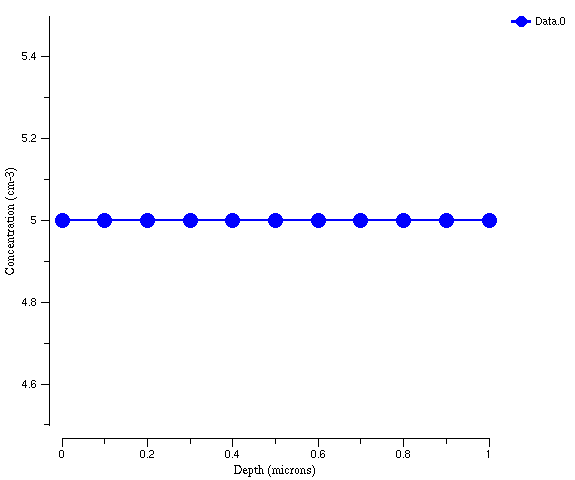Resistor example 1D - Create 1D structure explanation
Here's the code snippet from "1D Resistor Example" that will be explained on this page:
Create 1D struture
#Grid line x loc=0.0 spac=0.1 tag=Top line x loc=1.0 spac=0.1 tag=Bottom mater add name=Silicon region Silicon xlo=Top xhi=Bottom init #Contacts contact name=VSS Silicon xlo=-0.1 xhi=0.1 add contact name=GND Silicon xlo=0.9 xhi=1.1 add
The "#" symbol in tcl is a comment. These lines are ignored. The second line defines a grid point at x=0.0 um with 100nm-spacing around it. Usually we define x=0.0 as the top of the wafer, with positive x-values going down into the wafer. The "tag" will be used later to define material regions. The third line defines a grid point at 1 um with 100nm-spacing around it. Floods automatically decides how to grade the grid and fills in grid points in between the ones you have defined. If you'd like to see what the grid looks like in this 1D case, type
sel z=5 plot.1d symb=1
on the command line after you have init'ed the structure. This is what you should see:

The fourth line declares the label "Silicon" to be the name of a material ("mater") or region:
mater add name=Silicon
This label, as with everything else in Floods, is case-sensitive (i.e. "silicon" is not the same as "Silicon"). The "region" command labels all the grid points between "xlo" and "xhi" as "Silicon," and the "init" command parses all the previous lines and saves the grid structure in a database:
region Silicon xlo=Top xhi=Bottom init
Important boundary conditions are defined through the contacts of a device. The last two lines of this snippet define specific nodes on the grid as "contact nodes":
contact name=VSS Silicon xlo=-0.1 xhi=0.1 add contact name=GND Silicon xlo=0.9 xhi=1.1 add
Use "xlo" and "xhi" to draw a box around those nodes you would like to designate as "contact nodes." Note: do not use the "tags" here. Use numbers in um. Finally, Floods will search inside your box for any nodes that may be on the edge of your structure, or which shares an interface with another material.
You'll probably want to read a discussion of the default "Gas" material that is always there in Floods, and I'll probably put in link to that expression here some day. But for now you can wait until later because it's not really relevant to this very simple structure.